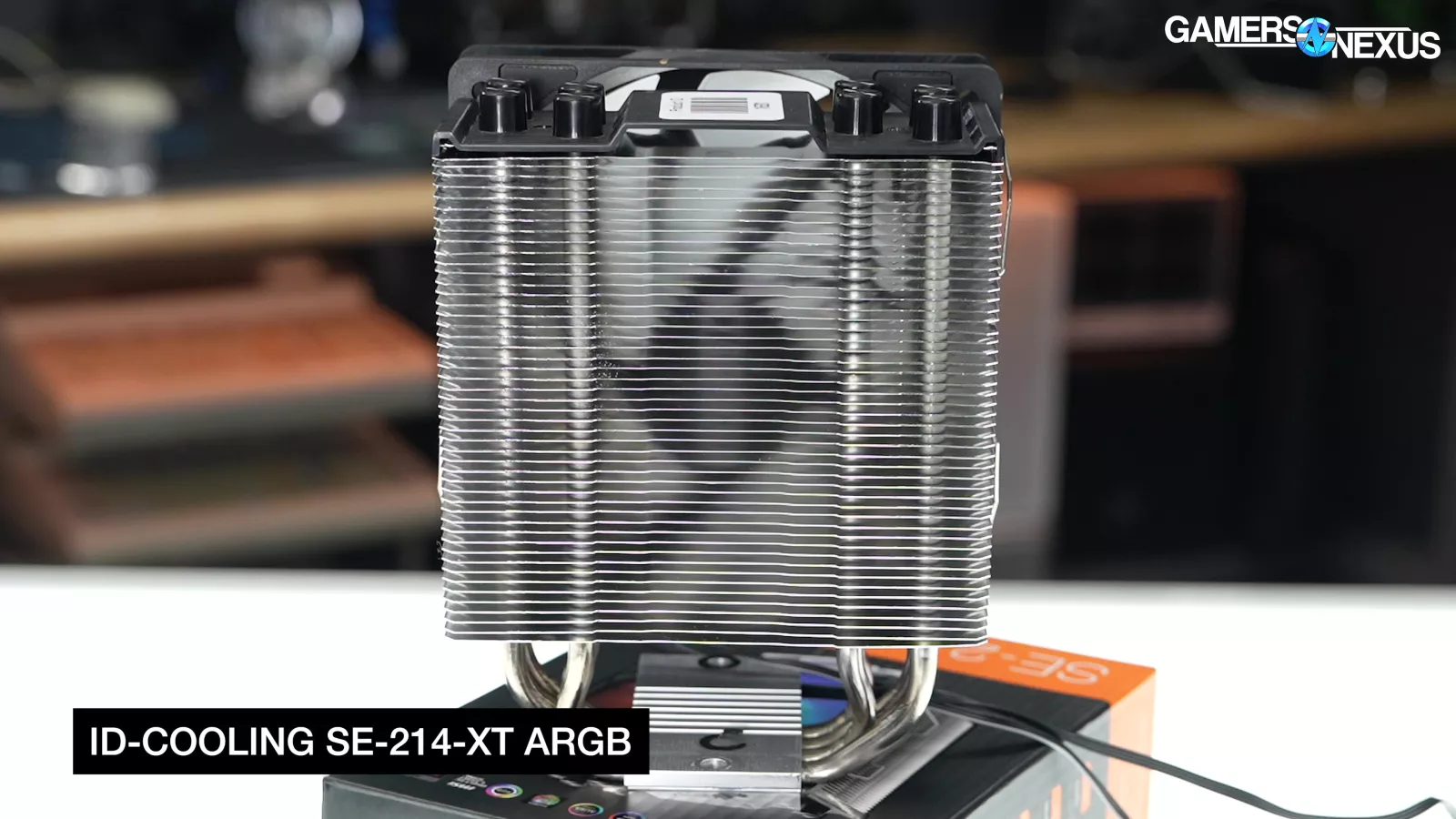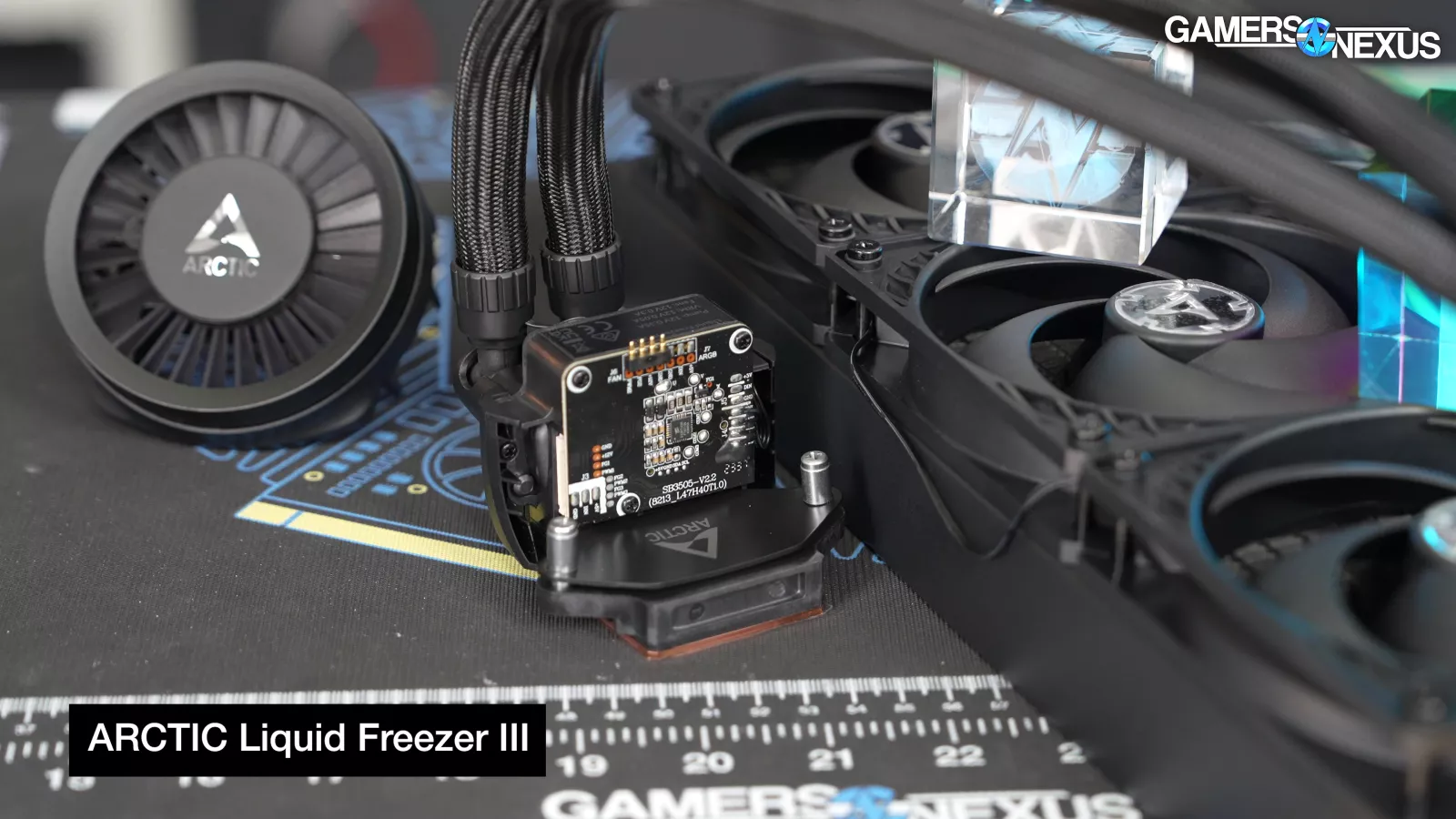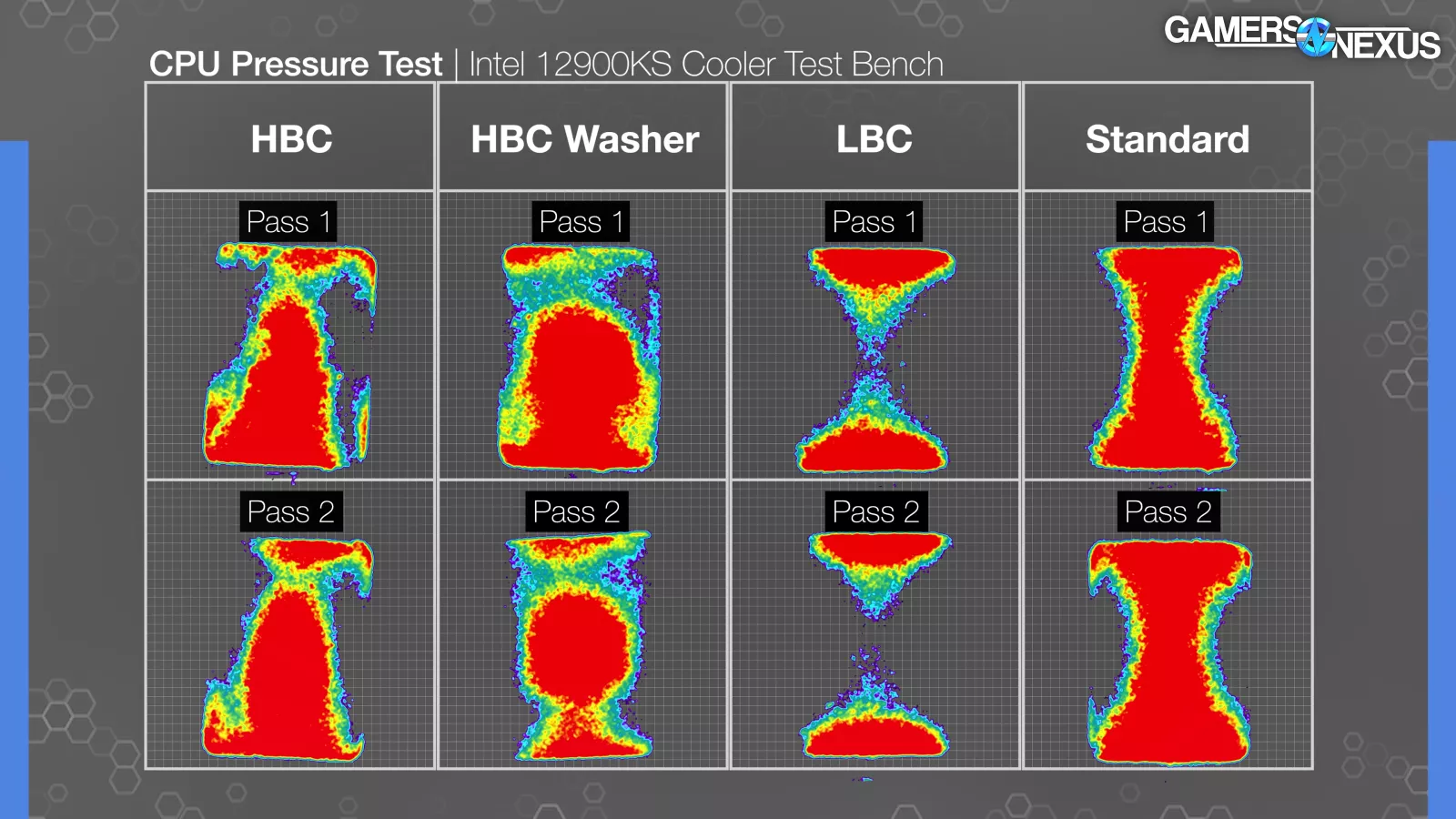
Our round-up includes the best CPU coolers for value, budget, noise-normalized thermals in both air and liquid categories, best mechanical design, and best overall.
The Highlights
- Best Overall CPU Cooler of 2024: ID-Cooling A720
- Best Value CPU Cooler: Thermalright Frozen Prism
- Best Budget CPU Cooler: ID-Cooling SE-214-XT
- Best Mechanical Design CPU Cooler: Noctua NH-D15 G2
Table of Contents
- AutoTOC

Intro
Today, we’re rounding-up some of the best CPU coolers that we’ve tested in recent years, including air and liquid coolers.
This is a continuation of our favorite series each year, where we get to have some fun comparing only the best-of-the-best products we looked at and avoid the usual disappointments. But there was some huge news this year: DeepCool got banned and is now gone from the US market. With that, a power vacuum has formed among cooler manufacturers, and Thermalright’s former nemesis has been replaced with Arctic and ID Cooling aggressively trying to fill it. We can’t say that was on our bingo card.
Editor's note: This was originally published on December 15, 2024 as a video. This content has been adapted to written format for this article and is unchanged from the original publication.
Credits
Test Lead, Host, Writing
Steve Burke
Camera, Video Editing
Vitalii Makhnovets
Camera
Andrew Coleman
Writing, Web Editing
Jimmy Thang
These tests will include results from our new 250W and 200W Intel heat loads in addition to our 200W and 123W AMD heat loads. The categories this year are for Best Overall CPU Cooler, Best Budget CPU Cooler, Best Value CPU Cooler, Best Noise-Normalized Thermals, and Best Mechanical Design. Let’s get started.

Setting Expectations
These Best Of articles are intended to get newcomers up to speed quickly, so we won’t go into the same crazy depth we normally do for the standalone reviews. Each of the coolers that has a review will be linked in the description below so that you can find the full details if you want them, including all the 3D laser scanning, pressure maps, and downsides. This article will be more of a flyover.
We’re testing both air and liquid coolers for this one. We’ve added a lot of coolers to the charts that aren’t in our prior reviews, specifically tested for this round-up, so there’s new data mixed with old in here.
Additionally, keep in mind that our noise testing methodology changes between charts. For the AMD platform, we use our old room-scale noise testing.
For our Intel platform we just added, we’re testing in our hemi-anechoic chamber with a lower threshold of 25dBA normalization in a noise floor around 14 dBA.
As always, for cooler round-ups, we can only discuss coolers we’ve directly had hands-on time with. There are hundreds of coolers out there. We have a pretty good cross-section of the big options, but if you don’t see exactly what you’re looking for, we’d encourage you to check other content and expand your research.
You can find the full charts on our CPU coolers Mega Charts page. As a reminder, gamersnexus.net is a free website that is totally free from third-party ads and funded by the audience. We just got done running another 18 cooler tests on a 250W and 200W Intel platform with noise-normalized results in our hemi-anechoic chamber.
That’ll set us up. If you want to check out our Best CPUs and Best Cases round-ups, those are already live. All the review links and product links are in the description. Let’s get into it.
Overview: Best CPU Coolers of 2024
| Category | CPU Cooler | Review |
| Best Overall CPU Cooler 2024 | ID Cooling A720 on Amazon | |
| Best Value CPU Cooler | Thermalright Frozen Prism on Amazon on Newegg | Thermalright Strikes Again: $56.90 360mm Liquid Cooler | Frozen Prism Review |
| Best Budget CPU Cooler | ID-Cooling SE-214-XT on Amazon | |
| Best Thermals (Noise-Normalized) CPU Cooler | Liquid Freezer III on Amazon on Newegg Noctua NH-D15 G2 on Amazon on Newegg | The New Best: Arctic Liquid Freezer III 360 & 280 CPU Cooler Review & Benchmarks Noctua NH-D15 G2 Review & Benchmarks, HBC & LBC Comparison, & Best CPU Coolers |
| Best Mechanical Design CPU Cooler | Noctua NH-D15 G2 on Amazon on Newegg | Noctua NH-D15 G2 Review & Benchmarks, HBC & LBC Comparison, & Best CPU Coolers |
Best Overall CPU Cooler: ID Cooling A720
Runner-Up: Arctic Freezer 36
Original review | Newegg | Amazon

Up first, our category for Best Overall CPU cooler this year. This category requires the pricing to be competitive, as it considers the value, the build quality and assembly features, ease-of-installation features, the thermal and acoustic performance, and everything else. Last year, we gave this to the Peerless Assassin 120, which is definitely a GOAT and remains one. This year, we’re giving it to two Thermalright competitors, depending on CPU: Overall, the ID-Cooling A720 gets the award this year. For our Intel bench specifically, we’re giving a tied rank award to the Arctic Freezer 36.
Let’s start with the Intel results and the Freezer 36, since that one is isolated as a winner to just this bench.
The most heavily weighted element in favor of the Freezer 36 (read our review) is its price. Arctic said it’d increase the price within just months of launch, but seemingly never did. Even today, the Black model that we tested is about $28 -- an incredible value considering its performance, at least on our Intel bench, and fiercely competitive with the Thermalright Peerless Assassin 120 that won our award last year.

Our new Intel 250W noise-normalized charts also include the Peerless Assassin 140, which was eliminated because we discovered quality control issues and variance between our two units that resulted in a 2-degree spread of results, which is actually huge. Unfortunately, one of the Assassin 140 units we have just doesn’t have a good pressure scan or laser scan, while the other is fine. We were able to prove the source of the difference was a combination of the coldplate and mounting hardware.
You can see the two entries for the PA140 here. It’s not because the white model is better, but because the other unit has contact issues.
Anyway, that eliminates the new PA140 even if only the best entry were here. Of the remaining coolers, the Freezer 36 is the best performer after Noctua’s D15 G2 HBC. This is impressive with the Freezer 36’s $28 price. The G2, on the other hand, is $150. Some of this comes from Arctic’s mandate of a contact frame for the Intel version of its Freezer 36, but considering that’s all included in the price, this is a strong positioning.
One other note here: The D15 2023 model we have here performs a little better than our original D15 from a decade ago, which is a result of minor tweaks or refinement in manufacturing processes along the way. We talked about this in the G2 review. If you’re on an older D15 from around when it launched, it’s likely it is marginally different in performance today.
On to the A720: In our Mega Charts for 200W testing previously, the Freezer 36 fell behind compared to its Intel results with the frame. This reveals our choice that’s tied for the category: The A720, which was also among the top two performers for Intel and is the best performer behind the D15 G2 (read our review) in this 200W, AMD noise-normalized test.

The combined chart-topping performance in both our AMD and Intel test benches is what leads the A720 to the Best Overall rank, with its relatively high build quality and moderate price securing the position.

At $55, with occasional drops to $50, it’s competitive with the best (like the $150 G2) and manages a 55.2 degree over ambient result on our 200W AMD bench. This improves on the GOATed Peerless Assassin by 1-degree, which does have a little bit of an advantage in price.

The Intel result improved on the Peerless Assassin 120 (read our review) by 1.6 degrees.
We recently tested the Phantom Spirit as well, but it didn’t outperform our Peerless Assassin 120. The Phantom Spirit EVO has a slightly smaller tower than the Assassin and also has a disadvantage with noisier fans, found in our chamber testing. The Spirit’s fan RPM is higher than the Assassin, but that doesn’t matter when normalizing for noise.
Overall, for the A720, we think it has surprisingly good build quality. The fans are well-fitted to the cooler, with the central fan sinking to benefit VRM cooling as well. We like the simplicity of the black model that we have. The mounting solution is overall straight-forward and the bulked-up 7-heatpipe design helps with coverage across the IHS. The cap plates are a nice touch without overdoing the branding. The central fan also levels-out nicely with the top plates and each fan has rubber bumpers on the corners to reduce vibration, which benefitted it in noise normalizing. Its biggest downside is size, where the 163mm height makes it about 6mm taller than a Peerless Assassin 120. This could limit some cases.
We think ID Cooling and Thermalright both are worth seriously paying attention to in 2025, especially with DeepCool’s disappearance from the US and the Freezer 36 is also worth considering if you happen to go Intel.

Best Value CPU Cooler: Thermalright Frozen Prism
Original review | Newegg | Amazon
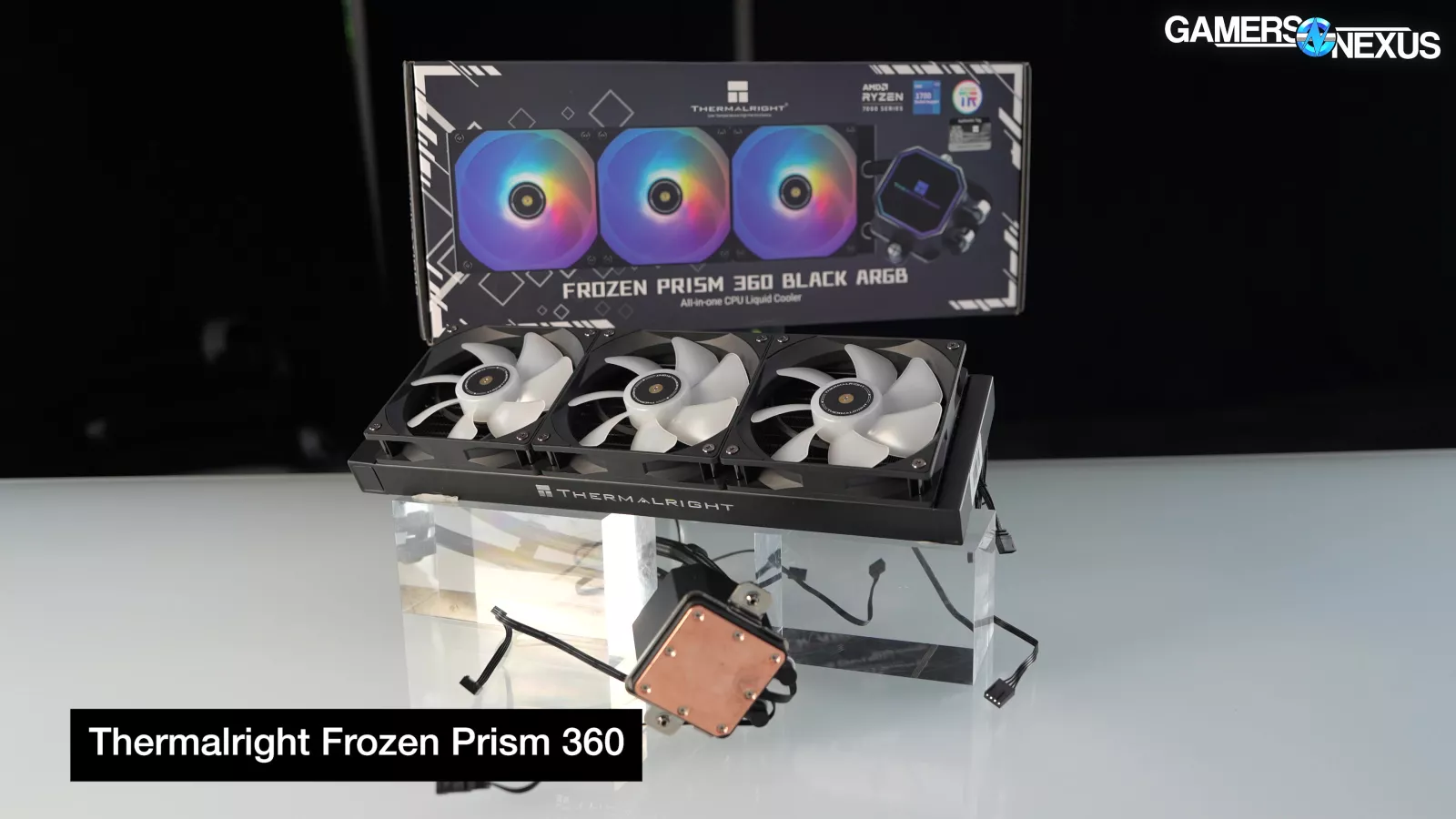
Our Best Value award this year goes to the Thermalright Frozen Prism. Value is judged by a combination of performance for the price, not just pure price. We have a Best Budget category as well for what is simply one of the best, cheap coolers.
Thermalright’s Frozen Prism is an enigma: It’s $52.71 at the time of this writing. This is somehow even cheaper than when we reviewed it. It’s cheap enough that we remain skeptical of whether it may have some sort of defect down the line. In some ways, it seems too good to be true. Concerns we have might involve gunk build-up, but we have no evidence of any such issues at this time. What we do have evidence of is impressive performance: The Frozen Prism (read our review) was a competitive liquid cooler in our testing, brute-forcing much of its performance with a hugely protruding copper coldplate, almost comically so. Our laser scans made this protrusion even more clear, with our pressure maps showing how the cooler leverages the design to brute-force high pressure dead-center, which is where the silicon often sits.
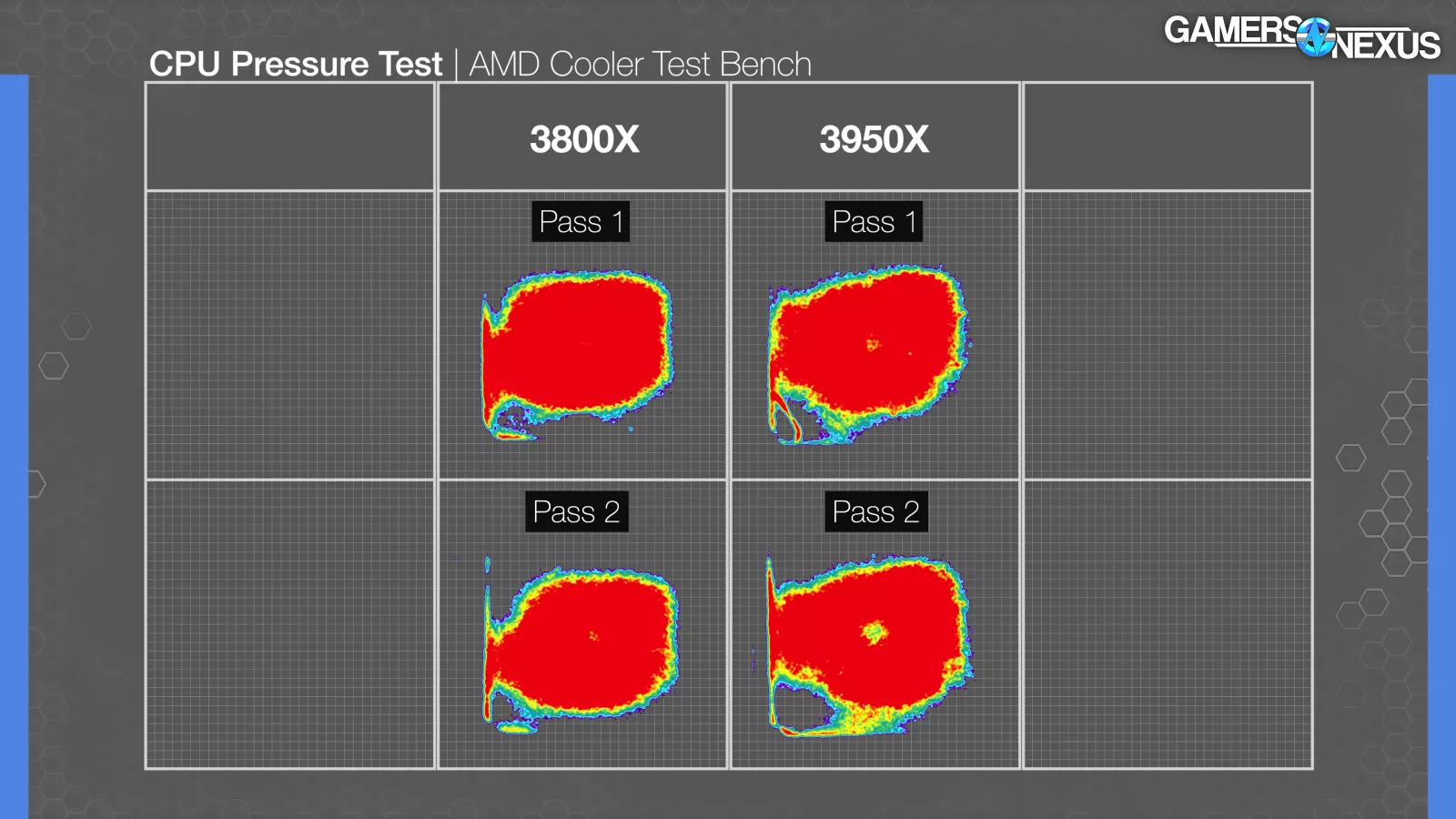
Even on AMD, which has less-centered silicon than Intel’s prior monolithic CPUs, the pressure spreads wide enough that it’ll catch everything.

In our 200W heat load thermal benchmarks from the review, the Frozen Prism 360 ran at 49.7 degrees Celsius over ambient when noise-normalized, whereas the best liquid cooler we’d tested at the time, the Liquid Freezer III, ran at 46.7 degrees Celsius over ambient. That’s a big difference. At the same time, achieving such close performance at under $60 was previously unheard of.

In our prior test bench configuration for Intel, using a 250W heat load on the 12900KS, the Thermalright Frozen Prism was a chart-topper when at 100% fan speeds. If you look at the 53.2dBA noise levels though, it was incredibly inefficient compared to the Liquid Freezer III 360, which ran at 39.8dBA. This is over a 2x increase in perceived noise to the human ear for the Frozen Prism, yet it drops only a couple degrees. That’s an inefficient trade-off, and although fan speed could be lowered to compensate for noise, it’s clear the cooler isn’t some mastery of thermal and acoustic engineering.
What the Frozen Prism actually is, though, is a mastery of cost engineering.
The Frozen Prism doesn’t have any real quality-of-life features to speak of or anything abnormal. It delivers what it promises, which is cheap cooling. Our only criticism of the physical construction, beyond some cheaper plastic-y feel of some parts, was the stiffer tubing. This can be worked around.
Thermalright has become known for flooding the market with countless options, to the point where it’s overwhelming even for its own staff to remember them all at tradeshows. The company is saturating listings and driving prices down, which is ultra-competitive and in some ways good for consumers. It’s also pretty cutthroat, and is why we now have name-brand coolers also dropping in price. Following-up its success with the Peerless Assassin 120 in years past, Thermalright is looking for a repeat in liquid. We’ll see how the Prism ages, but so far, it’s competitive, especially in thermals. That’s why the Thermalright Frozen Prism 360 gets our best value award.
Best Budget CPU Cooler: ID-Cooling SE-214-XT
The next award is in the same vein, but simpler: Our Best Budget award goes to the ID-Cooling SE-214-XT ARGB and it’s challenging the GOAT in Thermalright. ID-Cooling is vying for Thermalright’s strategy. Last year, we praised it for its overall value -- though it has been shifted into the pure budget category with the Frozen Prism’s addition to our charts.
The SE-214-XT ARGB has dropped in price and is now somehow $15.19 at the time of writing. We normally wouldn’t cite the pennies, but when 19 cents is over 1% of the total price, it suddenly becomes relevant. The SE-214XT ARGB is a simple, 4-heatpipe cooler that revives the approach of the old Hyper 212. It’s dirt cheap, its quality is flimsy, its plastics feel like they’re from McDonald’s toys, its coldplate is spartan, and yet somehow, the thing can handle moderate heat loads. It won’t handle a 250W CPU in our test suite with any level of satisfaction, but it’s good enough for cheaper and lower power CPUs with users on more extreme budgets. This would also be a good consideration if you’re buying a used CPU to save money and need something that ticks the “good enough” box.

In our 123W heat load on AM4 last round, the ID Cooling SE-214-XT ARGB held 58 degrees delta T over ambient when at 37.9 dBA, which had it more noise efficient for the result than the lower-ranked Hyper 212 RGB cooler. It was bordering on Noctua’s aged NH-U12S (watch our review). The Thermalright Assassin Spirit (watch our review) ran at the same noise levels and a little more than 1 degree cooler and is likewise a cheap cooler, but at $16.79, somehow, and this is really weird to say, it’s almost 11% more expensive. What a bizarre world of coolers we’re in.

In our 14900KF 200W heat load and with 100% fan speeds, tested instead in our hemi-anechoic chamber that purchases from the store help fund, we landed at 60.6 degrees Celsius delta T. That had the SE-214-XT ARGB as the worst performer on the chart, but still somehow capable of holding a stable operating temperature. In other words, it’s fine. The next lowest performer is the Scythe FUMA 3 (watch our review) with its combination of two fans, a massive 9 degree improvement.

Our 25dBA noise-normalized testing still has it at the bottom of the charts for this heat load, but even at this slightly reduced speed, it’s still a capable performer.
We wouldn’t call the SE-214-XT “good,” but we do think it’s one of the best in class at its seemingly impossibly cheap price, considering it also has to sit in freight to ship to wherever it’s sold. If you need a cooler to just get a system going, this is a good value. ID Cooling seems poised to challenge Thermalright in the future.
Best Thermals (Noise-Normalized) CPU Cooler: Liquid Freezer III, D15 G2
Liquid Freezer III original review | Newegg | Amazon
D15 G2 original review | Newegg | Amazon
Runner-Up: ID-Cooling Frozn A720
This is for the Best Noise-Normalized Thermals, and because we have both liquid and air coolers in the charts for this round-up, we’re assigning the award to one liquid cooler and one air cooler.

The Arctic Liquid Freezer III firmly receives the Best Noise-Normalized thermals award both overall and for liquid, but air can’t be expected to compete at the same level of liquid and large radiators (especially when dropping fan RPM). For air coolers, the award goes to the NH-D15 G2 HBC for Intel (or LBC for AMD), with a runner-up award for ID-Cooling’s Frozn A720. We’ve listed the latter because it’s $100 cheaper than the NH-D15 G2.
This is a thermal category, so we’ll focus on charts.
Starting with the Liquid Freezer III (read our review): Arctic’s revision of its Liquid Freezer II tried a number of new things, like shipping a mandatory contact frame with its Intel variation. This complicates matters and isn’t always for the best.
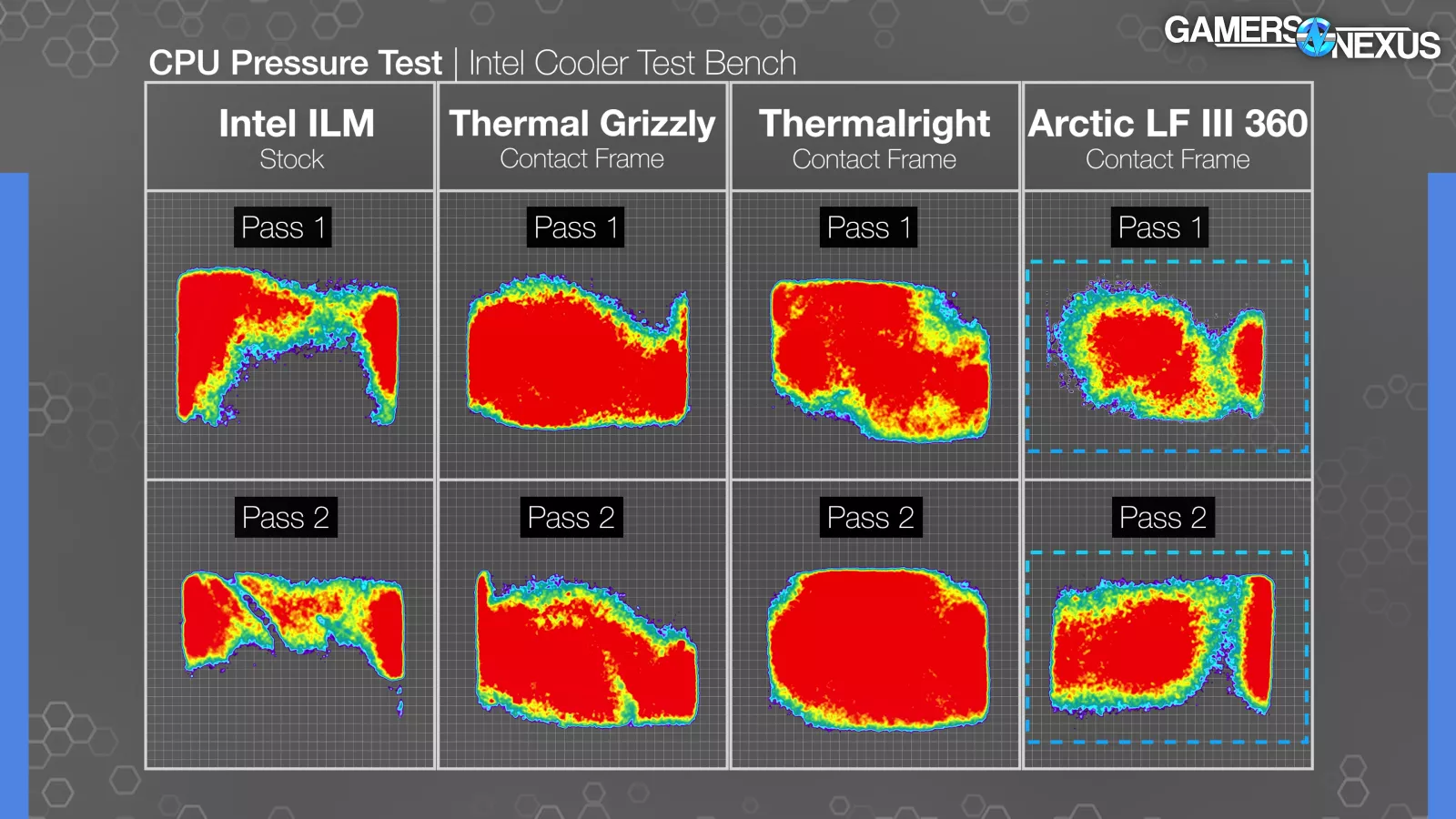
We found that Arctic’s contact frame was worse than other options on the market, but its cooler design was such that other options couldn’t be used instead. It was still better than Intel’s ILM, though.

For thermals, the Liquid Freezer III is just as impressive as its predecessor, and its price is similarly competitive. In 200W testing on AMD with our older noise-normalized approach, the Liquid Freezer III was the clear chart topper when we limited the pump speed to 70% (which helped reduce noise and allowed higher fan RPM instead). Running the pump at 100% and sacrificing some of that noise budget for it, it was still tied for second place, behind only itself and matched with a cooler that’s now banned in the US. The next closest non-Arctic option is the Trinity Performance from Lian Li, which is specifically performance-focused in its design.

In our Intel 250W heat load thermals on a 14900KF (read our review), also noise-normalized, the Liquid Freezer III with its mandatory frame climbs to the top of the chart. It’s ahead of the Frozen Prism by enough to not be margin of error or test variance. It’s also ahead of the Light Loop 360 and predictably ahead of all the air coolers.

The Liquid Freezer III remains a top recommendation of ours, though we do find its contact frame solution frustrating for Intel. On AMD, it’s much simpler.
Moving to the air coolers, the victor of the noise-normalized category on pure performance is the Noctua NH-D15 G2 HBC for our Intel 250W bench or LBC for AMD. Previously, we found that the G2 HBC outperformed even its closest competitor, the A720, by a couple degrees. This gap alone is impressive, as finding more than single-degree differences between air coolers is rare. Noctua’s work on the high base convexity cooler really worked for Intel -- but it’s also the recipient of our Best Mechanical Design category, so we’ll save that discussion.

On AMD 200W testing when noise-normalized, we also found Noctua’s D15 G2 LBC (or its flatter model) to be the current best noise-normalized air cooler result, behind only a huge stack of liquid coolers.

As some honorable mentions for runners-up here, since most are in the market for something cheaper, the ID Cooling Frozn A720 Black takes a clean second place in both our Intel and AMD CPU cooler testing. The Frozn A720 well balanced between the 2 platforms. It’s a relatively large tower that may have some clearance issues in some cases, but its $56 price-point makes it one of the more affordable, competitive coolers, and it’s $100 below the D15 G2.

Best Mechanical Design CPU Cooler: Noctua NH-D15 G2
Original review | Newegg | Amazon
The next award is for Best Mechanical Design. This covers the total execution of every physical feature of the cooler: Pressure distribution, laser scans, ease-of-installation features, a highly usable design, aesthetics, and the cooling itself. This year, we can easily give it to the Noctua NH-D15 G2. Like last year’s winner for this category, which was the Assassin IV, Noctua’s NH-D15 G2 isn’t a good value cooler (it’s $150, which is insane for an air cooler) -- but this category isn’t for value. We can still appreciate the engineering.
It’s extremely well-built and takes careful consideration of factors often ignored by other cooling solutions. The NH-D15 G2 was secretly developing something similar to what we showed with some custom-made Scythe cooler coldplates that we had Scythe make early this year, which was trying to game the coldplate convexity to better match the CPU heat spreader’s surface concavity or flatness.

Noctua was working on this for years and launched three models: The standard G2, HBC (or high-base convexity), and the LBC (low base convexity, sorry, Long Beach City) models subtly modify the convexity or flatness of the coldplate to better pair with deeply deformed Intel 13th and 14th Gen CPUs or with the relative flatness of AMD’s AM5 and AM4 CPUs with the LBC. Standard is meant to work on anything. We used our 3D laser scanner that we bought for cooler testing on the D15 G2 and discovered that the names really match the curvature.
We found that this wasn’t a gimmick and that there were actual, measurable and repeatable differences in benchmarks.
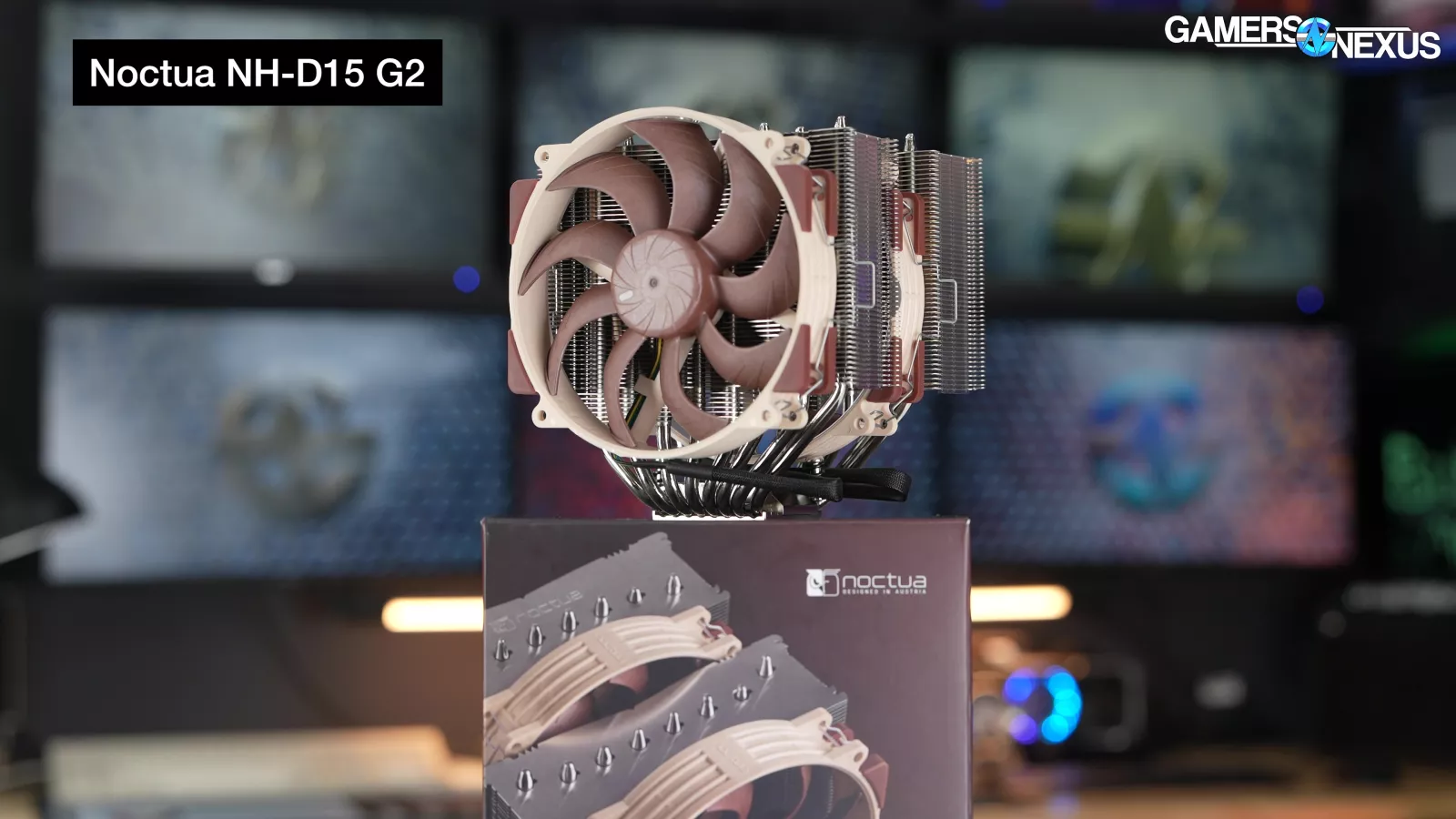
Noctua also lands on this list for its careful attention to detail on the fans, which it pairs and matches with slight RPM offsets intentionally in order to avoid a potential beat frequency phenomenon that could be annoying for some users. We have an interview with one of Noctua’s team members to talk about the engineering topics behind this.
The D15 G2 also had excellent pressure distribution as a combination of its mounting hardware and the coldplate, shown in our mix of pressure maps across AM4 and Intel.
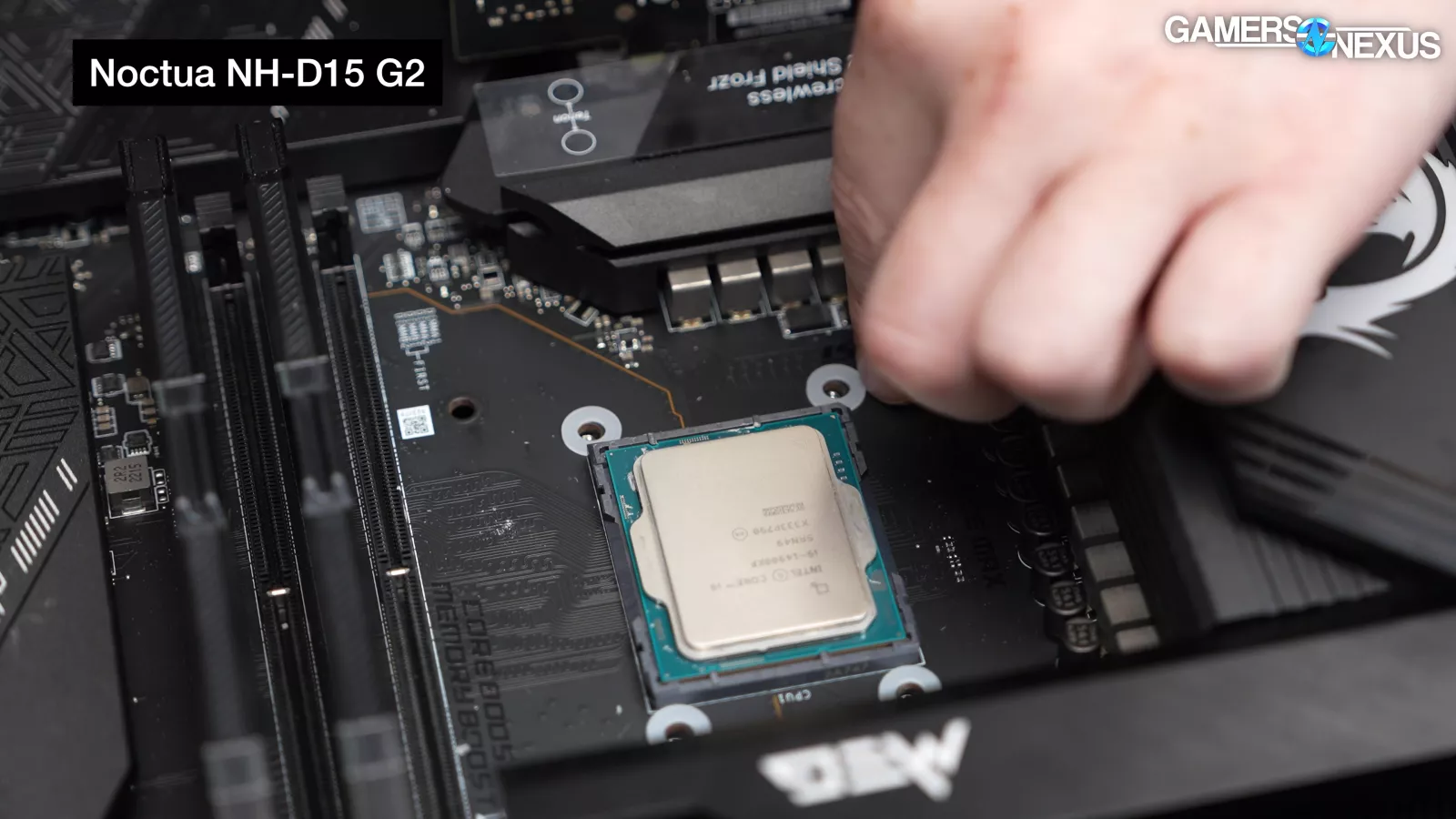
An included washer mod added some further fine-tuning and small touches, though it was also clearly an attempt to try and bulk-on a value-add with the high price.
Thermally, the D15 G2 didn’t blow away any of the other coolers by massive margins. It’s a good cooler, but spending $120 more than competition doesn’t mean it’s suddenly competing with a 360mm liquid cooler. The G2 with the HBC solution and a washer mod ran at 52.5 degrees delta T in our review results for the 250W Intel heat load, which was better than coolers like the Peerless Assassin by several degrees (and is impressive), but predictably behind a high-performance liquid cooler. The physics just won’t support beating water and the huge surface area of a radiator. Being realistic about performance expectations is healthy, though, and Noctua never claimed that.
We appreciate what Noctua has done with its mechanical and thermal engineering. The company may move slowly, but thus far, it has moved with purpose. As we said in our review, this is the type of thing you buy if you have your heart set on it and can afford it. You are buying Noctua’s name with the G2 and, likewise, its support. It has already delivered one free update for owners of G2s with a relatively minor rattle complaint.
















